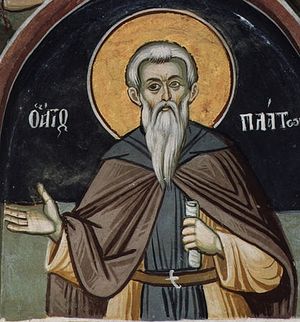Saint Plato was born in the year 735 into a pious Christian family of the parents, Sergius and Euphemia. Orphaned early on, the boy was taken to be raised by relatives, who gave him a fine education. When he grew up, he began life on his own. The saint occupied himself in the first years in the management of the property which his parents had left him upon their death. He was very temperate and hard-working and acquired great wealth by his toil. However, the future monk’s heart blazed with love for Christ. He gave away all his property, set his servants free and withdrew into a monastery named “Ensymboleion” near Mount Olympos.
His prayerful zeal, love of work and geniality won him the love of the brethren. When he was not praying he copied service books, and compiled anthologies from the works of the holy Fathers.
When the head of the monastery Theoctistus died in 770, the brethren chose Saint Plato as igumen, even though he was only thirty-five years old. After the death of the emperor Constantine Kopronymos (775), Saint Plato went to Constantinople. He resigned from the administration of the Metropolitan of Nicomedia. In 782, he withdrew to the desolate place of Studion with his nephews Saints Theodore (November 11) and Joseph (January 26). On the mount they built a church in honor of the holy Apostle John the Theologian, and founded a monastery, whose Superior was Saint Plato.
When Saint Tarasius and the empress Irene convened the Seventh Ecumenical Council in Nicea in 787, Saint Plato took an active part in its work. Being learned in Holy Scripture, he successfully unmasked the error in the Iconoclast heresy and defended the veneration of holy icons. When Saint Plato approached old age, he transferred the administration of the monastery to Saint Theodore.
In 795 the emperor Constantine VI (78-797) forced his wife to become a nun, and he married one of his relatives, Theodota.
Even though the holy Patriarch Tarasius condemned this marriage, Joseph, a prominent priest of Constantinople, violated the Patriarch’s prohibition and celebrated the marriage of the emperor.
When they learned of this, Saints Plato and Theodore excommunicated the emperor from the Church and sent a letter about this to all the monks. The enraged emperor gave orders to lock Saint Plato in prison and to banish Saint Theodore to Thessalonica. Only after the death of the emperor in 797 did they receive their freedom. Saint Theodore settled in Constantinople and became igumen of the Studion monastery. Saint Plato lived as a simple monk at this monastery under the obedience of his nephew.
When the new emperor Nicephorus (802-811) returned the excommunicated priest Joseph to the Church on his own authority, Saints Plato and Theodore again came forward denouncing the unlawful activities of the emperor. For this the brave confessors were again subjected to punishment in 807. They were jailed for four years. Saint Plato was freed from imprisonment in 811 after the death of the emperor, and he returned to the Studion monastery.
He lived three more years at work and prayer, and departed to the Lord on Lazarus Saturday at age 79, on April 8, 814. Saint Plato is honored as a Confessor because of his fearless defense of the holy icons.

